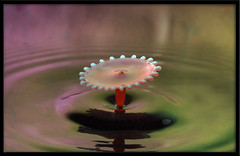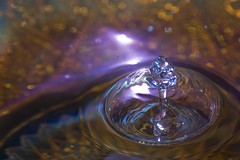Height
The height you drop the droplets from can really affect the final splash.
For most of my shots like :

The height was around 25-30cm
These drops were taken at around 45cm

However you can get some REALLY weird effects if you go up even higher. This picture was taken at around 2m (6.6feet). At this height the 'crown' forms a bubble and the spout goes through the bubble.

Liquid
Choose what liquid you use, Water gives splashier splashes, milk more perfect blobs. It's viscosity and surface tension have a big effect on the final result.
Viscosity
This is the 'resistance to movement' of the liquid. As you can imagine the viscosity can have quite an effect on the final result of a splash. Milk/Oil have different viscosities (is that a word?) and react differently when hit by a drop. I sometimes try increasing viscosity by adding glycerin to water.
Temperature
This is mostly the temperature of the liquid. Warm/hot water is less viscious than cold water. You get wider spouts with cold water (I think!) Milk works best if it's cold out of the fridge, when it gets warm instead of splashing outward it tends to fragment into other droplets.
Surface Tension
Surface tension of the liquid affects a number of things such as how the crown forms, how tall/wide the spout is etc. I sometimes use dishwasher rinse aid to lower the surface tension of water, it gives really tall thin spouts.
This is when it gets complicated.
Then you have to put it all together and get what you want. OR throw in a random selection of stuff and see what comes out (that's mostly what I do!) however keep a notepad of what you did (pref with reference to the pictures) so you can see looking back what the results were.. What I usually do is a set of pictures and when they copy to my machine rename them with stuff like :
WaterDrops Hot Water 30cm Glyc and Dye 001.jpg
So I can (mostly!) work out what I did.
Note that adding food dye affects surface tension. I think room temperature has some kind of effect, phase of the moon will probabily do SOMETHING to it too ;)
In the end it's chaos in motion... Experiment, try, get your kitchen soaked and covered in dye and hope to come out with 1-3 decent pictures that you can treasure at the end of the night :) (and if you dont.. try again the next night.. even with EXACTLY the same setup you can suddenly end up with 20 pictures out of 50 that make you go 'wow')
I quite often find that out of 500 pictures in a night I might get 5-10 decent pictures and they all come in the same group of 50... *something* went right at that point so it all came together.
This really is a project for winter nights, but keep posting, the information is priceless.
ReplyDeleteLove all the information you gave here. The definitions for all the various terms you've used really makes it easy to understand what you do when you set up. Great stuff and thanks a lot!
ReplyDelete